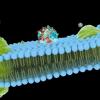The fact that the THF/nC60 made TNF more toxic is interesting. We know that fullerene products made in THF have their own set of toxicities that are due to THF artifacts. We've also seen reports of various problems with nC60, a nanoparticulate version. The avoidance of this was likely the point of Baati's preparation method that involved filtration and centrifugation. So this stuff is kind of doubly jinxed; it's hard to say what is the real cause of its toxicity enhancement.
TNF is an Immune System Cytokine that sometimes plays a positive role vis-a-vis pathogens. I'm not certain but that may be coincident with its becoming "cytotoxic." Does it become cytotoxic in its role of pathogen killer? Dunno. So a study showing that it is cytotoxic, per se, is consistent with its known paradoxical role.
The overview below is from a few years ago when the realization that cancer is also, in some ways, an auto-immune disease was becoming clear... TNF both fights and then promotes cancer. This paradox is what lies at the heart of diseases called "auto-immune."
Tumor necrosis factor (TNF) is a cytokine with well known anticancer properties and is being utilized as anticancer agent for the treatment of patients with locally advanced solid tumors. However, TNF role in cancer biology is debated. In fact, in spite of the wealth of evidence supporting its antitumor activity, the cascade of molecular events underlying TNF-mediated tumor regression observed in vivo is still incompletely elucidated. Furthermore, some preclinical findings suggest that TNF may even promote cancer development and progression. With this work we intend to summarize the molecular biology of TNF (with particular regard to its tumor-related activities) and review the experimental and clinical evidence currently available describing the complex and sometime apparently conflicting relationship between this cytokine, cancer biology and antitumor therapy. We also propose a model to explain the dual effect of TNF based on the exposure time and cytokine levels reached within the tumor microenvironment. Finally, we overview recent research findings that might lead to new ways for exploiting the anticancer potential of TNF in the clinical setting.
And it's that dual role that has implications for creating Oxidative Stress...
Transcriptional control of mitochondrial biogenesis and its interface with inflammatory processes
Major conclusions
Stimulation of the innate immune system by activation of toll-like receptors (TLR) generates pro-inflammatory mediators, such as tumor necrosis factor-α (TNF-α)and interleukin-1β (IL-1β), necessary for optimal host defense, but which also contribute to mitochondrial damage through oxidative stress and other mechanisms. To protect its energy supply, host cells sense mitochondrial damage and initiate mitochondrial biogenesis under the control of an inducible transcriptional program that also activates anti-oxidant and anti-inflammatory gene expression. This multifunctional network not only increases cellular resistance to metabolic failure, oxidative stress, and cell death, but promotes immune tolerance as shown in the graphical abstract.
Edited by wccaguy, 20 June 2012 - 12:17 PM.




















































